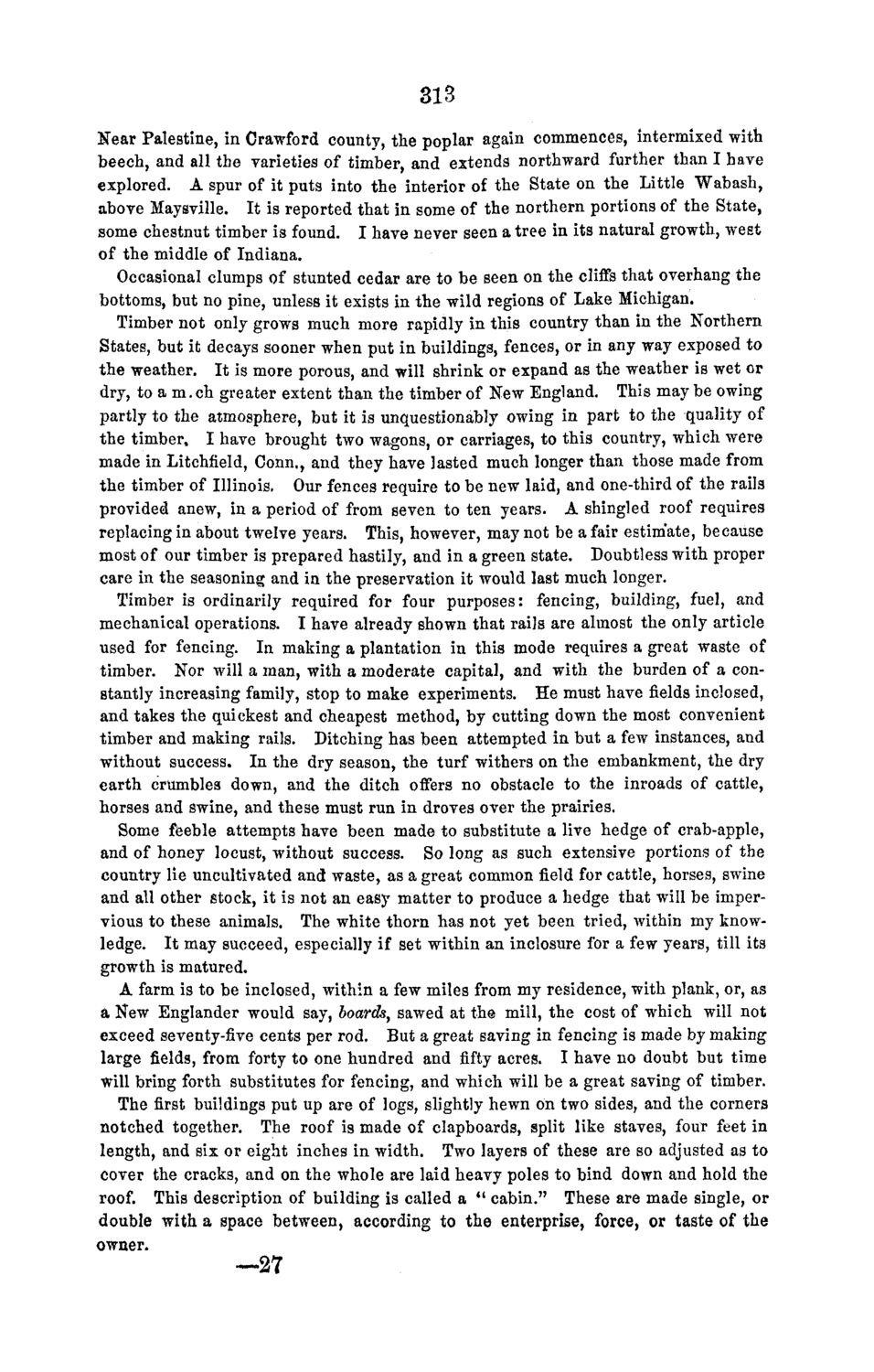| |
| |
Caption: Board of Trustees Minutes - 1868
This is a reduced-resolution page image for fast online browsing.

EXTRACTED TEXT FROM PAGE:
313 Near Palestine, in Crawford county, the poplar again commences, intermixed with beech, and all the varieties of timber, and extends northward further than I have explored. A spur of it puts into the interior of the State on the Little Wabash, above Maysville. It is reported that in some of the northern portions of the State, some chestnut timber is found. I have never seen a tree in its natural growth, west of the middle of Indiana. Occasional clumps of stunted cedar are to be seen on the cliffs that overhang the bottoms, but no pine, unless it exists in the wild regions of Lake Michigan. Timber not only grows much more rapidly in this country than in the Northern States, but it decays sooner when put in buildings, fences, or in any way exposed to the weather. It is more porous, and will shrink or expand as the weather is wet or dry, to a m.ch greater extent than the timber of New England. This may be owing partly to the atmosphere, but it is unquestionably owing in part to the quality of the timber, I have brought two wagons, or carriages, to this country, which were made in Litchfield, Conn., and they have lasted much longer than those made from the timber of Illinois. Our fences require to be new laid, and one-third of the rails provided anew, in a period of from seven to ten years. A shingled roof requires replacing in about twelve years. This, however, may not be a fair estimate, because most of our timber is prepared hastily, and in a green state. Doubtless with proper care in the seasoning and in the preservation it would last much longer. Timber is ordinarily required for four purposes: fencing, building, fuel, and mechanical operations. I have already shown that rails are almost the only article used for fencing. In making a plantation in this mode requires a great waste of timber. Nor will a man, with a moderate capital, and with the burden of a constantly increasing family, stop to make experiments. He must have fields inclosed, and takes the quickest and cheapest method, by cutting down the most convenient timber and making rails. Ditching has been attempted in but a few instances, and without success. In the dry season, the turf withers on the embankment, the dry earth crumbles down, and the ditch offers no obstacle to the inroads of cattle, horses and swine, and these must run in droves over the prairies. Some feeble attempts have been made to substitute a live hedge of crab-apple, and of honey locust, without success. So long as such extensive portions of the country lie uncultivated and waste, as a great common field for cattle, horses, swine and all other stock, it is not an easy matter to produce a hedge that will be impervious to these animals. The white thorn has not yet been tried, within my knowledge. It may succeed, especially if set within an inclosure for a few years, till its growth is matured. A farm is to be inclosed, within a few miles from my residence, with plank, or, as a New Englander would say, boards, sawed at the mill, the cost of which will not exceed seventy-five cents per rod. But a great saving in fencing is made by making large fields, from forty to one hundred and fifty acres. I have no doubt but time will bring forth substitutes for fencing, and which will be a great saving of timber. The first buildings put up are of logs, slightly hewn on two sides, and the corners notched together. The roof is made of clapboards, split like staves, four feet in length, and six or eight inches in width. Two layers of these are so adjusted as to cover the cracks, and on the whole are laid heavy poles to bind down and hold the roof. This description of building is called a " cabin." These are made single, or double with a space between, according to the enterprise, force, or taste of the owner. —27
| |